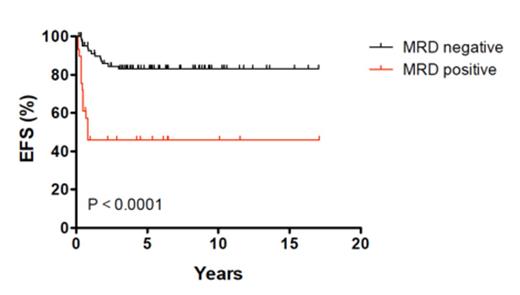Abstract
Background: Diffuse large B-cell lymphoma (DLBCL) can be cured with frontline therapy, but the prognosis of patients with relapse in the modern era is poor. Radiology scans (CT and PET) are commonly used as surveillance tools after therapy but do not improve outcomes and are associated with long-term health risks. Interim scans have also been used to identify early treatment failures, but are limited by false positives. Reliable predictive biomarkers that predict relapse may improve clinical outcomes. LymphoSIGHTª is a high-throughput DNA sequencing method that can detect and quantify circulating tumor DNA as minimal residual disease (MRD). We have previously reported its ability to detect circulating tumor DNA in serum after frontline therapy in DLBCL (Roschewski ASH 2013). Here, we analyzed the ability of serum MRD to predict both early treatment failure and relapse from remission in a large cohort of newly diagnosed DLBCL patients treated with curative intent.
Methods: Patients with DLBCL and treated at the NCI with EPOCH-based chemotherapy +/-rituximab between July 1996 and October 2013 had research serum samples collected pre-Tx, at each cycle, and at each surveillance visit. Surveillance visits included serum samples with paired CT scans at 3, 4, 6, and 12-month intervals for the first 5 years. Pre-treatment formalin-fixed paraffin embedded (FFPE) tissue specimens and/or baseline serum were de-identified and sent for identification of tumor-specific clonotypes. Tumor DNA was amplified using locus-specific primer sets for the immunoglobulin heavy-chain locus (IGH) complete (IGH-VDJH), IGH incomplete (IGH-DJH), and immunoglobulin k locus (IGK). Amplified products were sequenced, and patients in whom a high-frequency tumor clone (.5%) was not identified were excluded from the MRD analysis. Tumor-specific clonotypes were quantitated in the serum as MRD and analyzed for the ability to predict early treatment failure (interim monitoring) and relapse from remission (surveillance monitoring). Disease progression during therapy or <6 mos from completion was considered early treatment failure.
Results: 198 patients with DLBCL had pre-treatment specimens screened for a pre-treatment tumor clonotype with 3 excluded due to <10ng input DNA. When FFPE was available, 94 of 112 samples (86%) identified a clone while only 32 of 86 samples (37%) identified a clone without FFPE. The median age was 44 years (14-85) and an IPI risk groups included 56 low, 39 low-INT, 20 high-INT and 11 high. All patients who were MRD positive after therapy progressed. 101 patients achieved remission lasting > 6 mos and underwent surveillance monitoring. Eleven of these relapsed and 10/11 had a positive serum MRD at a median of 7.4 months prior to progression. The other 90 patients had sustained remissions and underwent a median of 11 surveillance CT scans (range 1-18). Dynamic monitoring of interim MRD (each cycle) identified early treatment failure (induction failure or relapse within 6 months) in 25 patients with a sensitivity of 81.8% and specificity of 87.5%. The positive predictive value (PPV) of interim MRD was 60% for predicting early failure while the negative predictive value (NPV) was 95.9%. The 5-year EFS of patients who were interim MRD positive was significantly worse than those who were negative (45.9% vs 83.0%, (p<0.0001)) (Figure).
Conclusions: Non-invasive dynamic monitoring of serum MRD during therapy predicts early treatment failure, while serial MRD monitoring during surveillance predicts relapse from remission in DLBCL.
This work was supported by the Intramural Research Program of NCI at NIH and Sequenta, Inc.
Kong:Sequenta: Employment. Zheng:Sequenta: Employment. Willis:Sequenta: Employment, Equity Ownership. Faham:Sequenta: Employment, Equity Ownership.
Author notes
Asterisk with author names denotes non-ASH members.


This feature is available to Subscribers Only
Sign In or Create an Account Close Modal